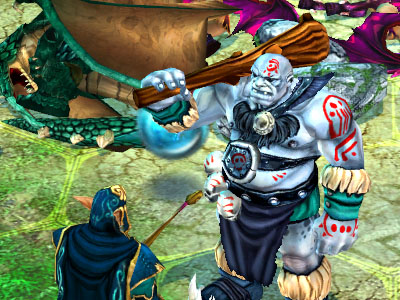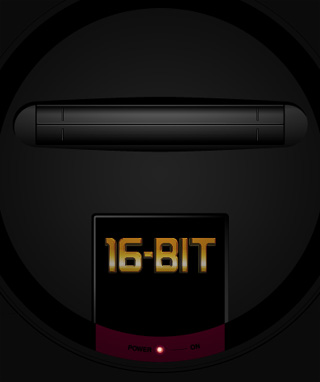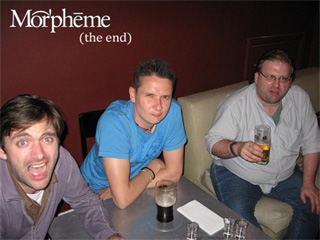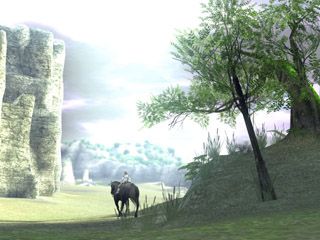Hello.
My name is Robin, and this is my website about computer games. Here you can find essays about old games, industry commentary, free games I've made for fun, and funny songs.

HBO’s gritty crime drama (“but it’s so much more than that…”) The Wire has gained a devoted following over the course of its five season run. If you’re already a convert, I won’t need to reiterate how far it stands apart from the typical procedural cop show, and how in terms of detail and structure is more like a filmed novel. You’ll already know that nearly every character is written and played engagingly and sympathetically, as if the sparingly-used ‘fan favourite’ characters from a dozen other shows have been concentrated into a single narrative, while still having completely believeable motivations. If you still need convincing, Charlie Brooker’s tireless evangelising of the show might sway you.
The brainchild of journalist David Simon and ex-detective/teacher Ed Burns, The Wire lifts the lid on the impoverished and crime-ravaged urban centre of Baltimore, Maryland, where police work is not neatly packaged with the villain led away in bracelets at the end of each episode. Characters responsible for morally indefensible (often violent) acts are portrayed as everyday people with mundane concerns, attempting to reconcile their circumstances with a normal life. Initially focusing on the city’s ascendant drug empire (the Barksdale Organisation) and the investigative unit tasked with bringing them down (initially placing a tactical emphasis on telephone surveilance, hence the show’s title), each series introduces new factions (politicians, press, blue collar workers, the public school system) into the mix.
Before The Wire came along, I had long written off TV as an entertainment medium with any untapped potential. I assumed that commercial pressures and perceived audience tastes condemned the box to offering slick but ultimately disposable amusements such as Lost, Life on Mars and Arrested Development. Looking at post-Wire TV output sadly suggests that this is still largely true, although the show was a reminder that there are still some enclaves within that industry prepared to nurture more sophisticated fare.
The Wire’s fictionalised version of Baltimore is a complex network of institutions and social groups, each to a greater or lesser extent dysfunctional and (barely) held together by the concerted actions of diverse characters with their own agendas. This sounds to me like fertile material for adaptation to a video game. Of course any such suggestion would undoubtedly be met with dismissive sneering, as we’re all weary of the the typically poor treatment of TV and film licenses (GoldenEye 007 and Chronicles of Riddick being rare exceptions). Assuming for a moment that The Wire license ended up in capable hands, and that it would be worth at least trying to do justice to the source material instead of perpetuating the status quo, what sort of game would work?
Tags: adaptation, beat-'em-up, HBO, intellectual property, licensing, pitch, social games, strategy, television, The Wire
Over the last few months I’ve signed up to various alpha- and beta-tests of games in development. Ones that I’ve spend an appreciable amount of time exploring are Metaplace, Quake Live and Magnetic Billiards – three very different projects, all of which promise technological innovation of one form or another (well, except perhaps Magnetic Billiards, which has charms of its own nonetheless). In the light of the NDAs attached to these tests (and the spirit in which participation is entered into), I don’t reveal anything below that hasn’t already been made public through previews, press releases or demonstrations that can easily be found on games sites and/or YouTube. Consider this a heads-up/reminder/call to action (delete as applicable), not any kind of review.

Metaplace is the current project of Raph Koster (designer on Ultima Online and Star Wars Galaxies and author of A Theory of Fun for Game Design). It’s a ‘general purpose’ virtual world platform intended to allow users of all skill levels to build virtual environments which other users can then visit directly from the browser. The main vector by which Metaplace worlds are intended to be propogated is (of course) social networking sites like Facebook, MySpace and Bebo, with the ultimate goal of making virtual worlds an everyday piece of web furniture as images, links, embedded YouTube videos and enormous content-obscuring Flash adverts. This integration works both ways, as online content can be easily dropped into Metaplace worlds (including the rather nifty ability to import objects from Google’s 3D Warehouse).
Metaplace could be seen as an antidote to Second Life, designed around the likely uses to which such tools would be put (based on decades of experience with MUDs and MMOs) rather than attempting to replicate the impractical science fiction metaphor of a single, anarchic ‘cyberspace’.
Tags: Alpha, Beta, game title, Id Software, Magnetic Billiards, Metaplace, Pickford Brothers, Quake Live, Raph Koster

King’s Bounty: The Legend (KB:TL) is the latest product of the burgeoning Russian game development scene to have piqued the interest of Western PC gamers. It was brought to my attention by Rock Paper Shotgun whose initial puzzled amusement seems to have snowballed into championing the game as a shining example of where PC games should be going and how Russian developers are going to be riding the crest of that wave.
KB:TL is a strategy RPG taking its name and inspiration from Jon Van Caneghem’s 1990 game King’s Bounty, generally seen as the forefather of the Heroes of Might and Magic series. For the uninitiated, the HoMM games were sort of a fantasy version of Civilisation. The player would move one or more hero units (each accompanied by an army) around a turn-based overworld map, collecting resources, visiting (and laying siege to) settlements, and battling enemy heroes.
Combat was represented on a single-screen hex grid, with each legion of the same type of unit (‘stack’ in game parlance) represented by a single animated sprite. This representation allowed battles to be fast-moving and easy to follow without completely foregoing strategic subtlety, and also rewarded the player with a bit of gladiatorial eye candy (anyone who remembers Battle Chess will appreciate how much more engaging turn-based battles become when the pieces graphically knock seven bells out of each other).
KB:TL makes significant changes to the HoMM formula. The player now only has to worry about a single hero (and their army), who acts as their avatar. Managing settlements has also been omitted, with the various castles and buildings visited by the player mostly acting as shops where equipment, troops and spells can be purchased, or dwellings for quest-dispensing characters. The overworld is now navigated in real-time, and consists of several large continents or realms, each broken into several smaller areas. Completing main-line quests progressively opens up new areas of the world. (I found that at normal difficulty, resources were scarce and enemies tough enough to require most of the optional subquests and dungeons to be completed just to scratch together a strong enough army to progress.) The net result is that King’s Bounty feels more like an RPG and less like a generic strategy game.
Tags: 1C Company, Game, game title, heroes of might and magic, katauri, king's bounty, king's bounty: the legend, PC
Engineers are a peculiar bunch. Anyone seeking proof of this need only attend a local Dorkbot gathering. Billed as “people doing strange things with electricity”, Dorkbot meets are informal, sometimes ‘open mic’ gatherings of likeminded hardware hackers, held every few months in cities around the world, which provide a platform for artists and engineers (and various combinations thereof) to talk about their more creative and unusual projects.
The London chapter’s Christmas event, held last night at Limehouse Town Hall, showcased an impressively broad range of contributions, including flying an illuminated UFO over Gdansk, an experiment to ascertain if a person was gay by measuring their brainwaves (really), and even a slide-whistle playing robot.
Of course, such efforts to derive amusement from electronic hackery also result in some things that can be classified as games (or at the very least software toys). Two regular Dorkbot contributors are particularly interested in the interactive arena: Tim Hunkin and James Larsson.
Tim Hunkin (cartoonist and erstwhile presenter of Channel 4’s The Secret Life of Machines) has spent the last few years building a collection of electro-mechanical and video-based attractions for his amusement arcade on Southwold Pier.
Hunkin’s ideas tend to be unconventional and satirical although with few exceptions they’d be more accurately described as art installations or mildly interactive rides rather than actual games. This time, in accordance with the evening’s loose theme of ‘Sleaze’, Hunkin showed a buttock-measuring machine, an autofrisking booth (for people who suspect themselves) and his latest creation – a housefly simulator.
James Larsson‘s presentations are interesting for different reasons – even by Dorkbot standards the products of his imagination tend to be rather strange. In 2006 he unveiled the seminal Leather Fetish Pong, an implementation of the classic two-player game in which players control the paddles by gently squeezing sensor-equipped thigh-length boots.
Larsson’s leadership in the field of creating the most improbable system for playing Pong was shortlived however, as the following year Iain Smith presented the less pervy but more energetic Cyclepong (which is exactly what it sounds like).
With the gauntlet thrown down, this year Larsson unveiled plans for the last word in absurdist Pong implentations, the “nuclear option” that he hopes to never have to build: Sheep Shagger Pong. (“If their Pong gets on the Gadget Show, I’m going to build a Pong that gets on Crimewatch!”) Thankfully the game (complete with lifesize – rumble-equipped – model sheep controllers) only exists on the drawing board for now.
Larsson did however bring along something that the attendees could play (which was even within the bounds of taste and decency) – Incandescent Conkers. This game was played by taking two incandescent filament lightbulbs and hooking them up in series to a microwave oven transformer, with the current being regulated by a sensor which was activated by vigourously striking a toaster with a riding crop. (It was at this point that I started to wonder if I’d accidentally walked in on a live action version of Earthworm Jim.) Whack the toaster to send a ridiculously excessive jolt of power through the bulbs, and whichever bulb survives longest without blowing is the victor.
The mechanic of violently thwacking a toaster to produce proportionally intense flashes of light is surprisingly exhilarating. In fact, many of these type of Dorkbot projects suggest that there is a lot of untapped potential in using physical and mechanical actions as input for games, beyond the fairly narrow range of motion controls we’ve so far seen enabled by the Wii Remote, or the scattering of specialised peripherals used by Guitar Hero and its ilk. Hopefully we’ll see more developers experimenting in this area in search of the next big super-accessible hit – just so long as they leave the sheep out of it.
Tags: dorkbot, game title, james larsson, pong, tim hunkin

I’m slightly late with this one (the Mega Drive’s birthday was on the 29th October) but I realise that I’ve never written anything on this site about the console that was in many ways Sega’s greatest contribution to gaming outside of the arcade – and certainly the system that had the greatest transformative effect on my own view of games.
There is an irritating tendency in retrospectives about the Mega Drive to focus on how it disrupted Nintendo, rather than examining what the machine (and its software library and ethos) achieved in its own right. Anyone reading these articles would think that the Mega Drive shot to success purely on the back of Sonic and Madden and then almost immediately went into decline as Nintendo’s ‘rightful’ mastery was reasserted (that is, if you narrowly regard the SNES’s library as the peak of 20th Century human achievement, as a worryingly large number of people seem to do).
The familiar tale of how Sega managed to throw away the 16-bit crown through the proliferation of ill-concieved upgrades and peripherals makes for a gripping yarn (see Steve Kent’s book The First Quarter, which most retrospectives crib from heavily), but that all happened towards the very end of the Mega Drive’s commercial life. Before the wheels fell off the Sega Bus there was a period of at least five years when the MD was a significant force in the industry, playing host to a broad and frequently boldly innovative assortment of games.
(A biography of Elvis that was totally preoccupied with how he wound up dead on a toilet would be missing the point somewhat, and the same principle applies here.)
Tags: brand loyalty, commentary, gunstar heroes, history, landstalker, manic street preachers, mega drive, nintendo, sega, shining force, snes, sonic, streets of rage 2, toejam & earl, unified platform

Achievements. Trophies. Badges. They go by many names, but the concept of doling out meaningless (and yet strangely compelling) “meta” rewards for completing a catalogue of in-game tasks (ranging from the trivial to the impossible, the obvious to the obtuse) has become practically mandatory for any new game or platform.
Xbox Live popularised the idea and laid out the modern blueprint that most subsequent systems have followed. Playstation Network, Steam, NGAGE, World of Warcraft and Warhammer Online followed with their own systems. Most casual web games (and in fact, many “Web 2.0” sites, even some with no direct affiliation to gaming) have implemented similar systems, rewarding community interaction. (Interestingly, Nintendo haven’t jumped on this bandwagon yet, although Metroid Prime 3 had it’s own discrete award system, and it could be argued that games like Super Smash Bros have offered achievements in all but name for years.)
In all seriousness, I would be surprised if the next version of Microsoft Office didn’t have a medal to collect for successfully completing 20 mail merges.
There have already been lots of discussions about the effect that achievements have on player psychology, and whether the bizarre practice of buying unappealing games with the intention of ‘farming’ them for easy points has any wider negative impact than on the idiots wasting their time indulging in it. I’m not going to retread that ground here.
Tags: achievements, badges, commentary, playstation network, steam, trophies, xbox live

“People forget that to get the golden egg, somebody has to fuck the goose.”
Scott Foe, Producer of Nokia’s Reset Generation
Last Monday I was invited to take part in the 4Talent Mobile Games Pitch.
This event, now in its second year, saw nine finalists chosen from over 200 entries and invited to Channel 4’s headquarters near Westminster for an intensive day of presentations and mentoring sessions about games design, the potential of the mobile platform, and the art of delivering a successful pitch for a creative project.
At the end of the day, each finalist would pitch their game idea to a panel of judges, with the winner being presented with a £1,000 prize at the 2008 Golden Joystick awards, and the option of a placement at EA Mobile and/or Nokia (the specifics weren’t entirely clear on the day).
Tags: 4talent, channel 4, channel 4 mobile games pitch, games i've done, mobile games, way of the dodo
I’ve always been a big fan of robots. From an early age I was immersed in a culture of Usborne books, Tomy-bots (I’m still working on a plausible sounding reason to spend £200 on this little guy), Asimov’s Laws, Capsela, Kryten, Marvin and Nono. (Although no Transformers, oddly.) Aged six I even won a prize in a fancy dress contest for flailing around in a cardboard robot suit that had more effort spent on tinfoil dials and buttons than adequate eyeholes. (NSJ, yeah?)
As a result, any game featuring robots is likely to pique my interest, especially when they’re old-skool, LEDs-for-eyes, bleep-bloop retro-futuristic ‘bots of the sort Maggie Philbin had convinced us would be moving in next door by 1990.

Droid Assault, as the title suggests, features dozens of the blighters (48 distinct varieties in fact), who have quite stereotypically run amok in the warehouses and factories of their creator, Omni Corp. The player is tasked with bringing the situation under control by destroying or capturing all the droids on each level. The basic framework is lifted from the C64 game Paradroid, although afforded a more action-oriented slant thanks to the implementation of mouse aiming and cursor key movement controls.
Tags: droid assault, Game, game title, indie, paradroid, PC, puppygames
Age classification for games in the UK is currently undergoing an upheaval. Presently we have a dual system, with the voluntary Europe-wide PEGI system applied to all games, and the legally enforceable BBFC 15 and 18 ratings also used in cases which fall under the BBFC’s remit (i.e. games with graphic violence, sex and adult themes).
The government commissioned a television psychologist to assess the situation and make recommendations. She recommended that the BBFC’s remit be extended to cover 12-rated games as well. This was a kneejerk response intended to justify the cost of the report, and its benefit to the public was never clearly explained.
Now there are rumblings that the government want to hand the whole process over to the BBFC. The BBFC seem to be quite keen on the idea of having a government mandate to shake down the games industry for additional millions of pounds each year, regardless of whether this is in the public interest.
Edge Online have published a column by BBFC chief David Cooke. It’s commendable that Edge are giving both sides of the debate a platform as opposed to only giving PEGI, ELSPA and the industry’s views an airing. A shame then, that Mr. Cooke’s arguments are trivially weak:
“It’s often forgotten that some of the biggest games countries in the world are not in PEGI but do their own games classification: for instance, the USA, Japan, Australia, and, within Europe, Germany. The public understands that different countries have different national sensibilities that need to be taken into account.”
I’m sure it must come as a surprise to many to learn that non-European countries aren’t part of the Pan European Games Information scheme. America has it’s own voluntary system (ESRB) which is broadly similar to PEGI, but kept from being legally enforcable by cultural and constitutional issues. Australia has a universally derided government-backed system which does not have any mechanism for rating games for adults.
Germany, here cited as an example of PEGI’s inability to address local sensibilities, uses its own system because it has by far the strictest censorship laws in the Western world. The UK, and the rest of Europe, does not have such excessively strict censorship enshrined in law (much to our merit), so the comparison is specious.
“There’s nothing wrong with a multi-national approach like PEGI, but you can see the problems involved in trying to regulate and enforce across dozens of countries.”
This statement is conspicuously vague, possibly because the PEGI system works, throughout Europe, and has done for several years now.
Mr Cooke then gets onto the topic of whether the BBFC had the resources to perform this work (which is much less relevant than the issue of why it should be doing it in the first place, and whether it is qualified to do so).
“I really reject the notion that the BBFC can’t handle issues of scaleability. Look at the DVD market. In 1997 we had just over 3,000 DVDs to classify. By 2006 that had risen to to over 15,000, an increase of 460%.
“In comparison, we do about 300 games a year at the moment.”
An organic rise in DVD releases (which obviously occurred in tandem with a decline in VHS releases) over nine years is in no way comparable to the immediate jump of several hundred percent which would occur if the BBFC were tasked with rating most or all games. Most of this influx of new titles would be content (children’s and family games) that the BBFC has no prior experience in dealing with.
The piece wraps up with some claims about the expertise and rigour of the BBFC’s process. I’m sure they’re perfectly competent, but that doesn’t make them any less redundant (not to mention expensive, obstructive, needlessly time consuming and likely to have chilling effects on artistic expression and consumer choice) when we already have a system that works in PEGI.
Tags: bbfc, censorship, commentary, pegi

On June 30th 2008, after nine eventful years, London-based games developer Morpheme Game Studios officially ceased to exist.
You’ve probably not heard of Morpheme. Like dozens (perhaps hundreds) of other small developers in the UK, they quietly went about their business for years without ever being thrust into the limelight by a blockbuster hit or groundbreaking invention. For most of their history, Morpheme made games for mobile phones, and later branched out into Flash and downloadable casual games.
As none of Morpheme’s games had a physical manifestation, it’s sadly quite likely that most of them will sooner or later be impossible to obtain. I have therefore decided to write a brief history of the company to record for posterity that they did at least exist. (And also because they employed me for several years.)
I first became aware of Morpheme by chance when my university tutor referred me to them for a Summer internship back in 2000. At that time the company consisted of its three founders: Matt Spall, Lucy Reed and Andy Fitter, all industry veterans who had previously worked at Virgin Interactive and/or Psygnosis/SCEE. Morpheme HQ was initially a cramped office in a converted dress factory in London’s fashionable (for tramps) Kentish Town.
Morpheme had originally targeted the Game Boy Color (if I remember rightly), but finding that market monopolised by established players (such as Crawfish), the trio had turned their attention to the nascent mobile sector. At that time few other companies in the UK were working in mobile, the most notable being Digital Bridges (now known as I-Play).
The technology to allow phones to download applications (including games) was just emerging in Japan but was still years away from reaching Europe. The only option available in those early years was making client-server games which were played through the phone’s browser using WAP. If you consider that web browsing on modern phones is less than ideal, then try to imagine what it was like eight years ago and you can probably appreciate why WAP gaming didn’t take off.
Tags: balloon headed boy, commentary, croc, infocom, mobile games, morpheme, retrospective

Games developers are illusionists. Convincing players to mentally conjure places, people and stories out of rudimentary arrangements of switches and blinking lights demands something more than just engineering skill. As hardware has grown ever more powerful and sophisticated, the need for creative sleight-of-hand has not diminished.
That whizzy new console may provide a leap in processing and effects over its predecessors, but the novelty quickly palls leaving developers searching for increasingly cunning techniques to make this year’s blockbuster outperform last year’s while constrained to the same hardware.
One of the deepest and nerdiest pleasures of the games enthusiast is discovering how the trick works. I can reel off some personal favourites from games I’m most familiar with, but to get a truly diverse view I plundered the collective RLLMUK Forum memory-banks in this thread. Read on for ten of the most celebrated examples of gaming smoke and mirrors (with YouTube links where applicable).
Tags: another world, commentary, donkey kong country, doom, elite, graphics, nebulus, red zone, savage, shadow of the colossus, smoke and mirrors, top gear rally
Things which can be appropriately described as a “nation”:
Things which cannot:
- People who like certain American sports which EA holds exclusive rights to, severely limiting their ability to choose games based on quality, or in extreme cases, basic fitness for purpose.
Referring to such as the “EA Sports Nation” might come across as rather presumptuous, don’t you think?
(More substantial new content is on its way. Check back soon…)
The three console manufacturers have made their annual addresses to US retail laying out their wares and plans for the rest of the year. The general consensus seems to be that this was very much business as usual, with no earth-shattering announcements.
Microsoft reeled off an impressive array of third party content, all of which will also be available on the PC and/or the PS3, with no new announcements. Their first-party efforts were largely focused on playing catch-up with the Wii (this month’s NPD figures are expected to show the Wii overtaking the 360 in the US, and without a significant price cut announced that gap is only going to widen), with increasingly-tired Scene It and Viva Pinata retreads being joined by a Singstar clone (Lips) and a technically simplistic Eyetoy-style game (You’re In The Movies). A protracted and awkward on-stage demo of the latter revealed it to be a video version of Mad Libs, which output very rough looking chromakey’d skits that wouldn’t have looked out of place on the Kenny Everett Television Show.
Their big reveal was that Final Fantasy XIII will be coming to the Xbox 360, which is perhaps inevitable considering the series’ popularity in the US. Tellingly the 360 version is not slated for a Japanese release. Square Enix also showed a raft of other RPGs (one of which was openly stated as being PC-bound), demonstrating that Microsoft’s strategy for the Xbox 360 in Japan is to continue plodding down the Mistwalker route, providing isolated games that appeal to genre fans without building a software ecosystem around them that would justify a more general audience buying the machine.
Tags: commentary, e3, microsoft, nintendo, playstation 3, sega, wii, xbox 360
I don’t want to make a habit out of making fun of people on this site, but this week Microsoft’s Aaron Greenberg (who we saw defending the insane pricing of the Xbox 360 HDD a while back), is coming out with stuff that’s too good to ignore:
“I think that there’s a difference in the type of customer that is buying the Wii. When you think about it, there’s a difference between trying to be the number one console with nine year old gamers, and being the console that offers the most experiences from 13 to 33…
You see they’re not buying games on it, right? They’re buying it, it’s like something they break out when people come over, and it’s maybe a fun thing, but it’s almost like the same people that buy a karaoke machine, you know? They’re not really buying it for games, they’re just buying it as a novelty.”
In other words: “Nintendo is for kids! Local multiplayer games are not real games! Fun is sooo immature!” Embarrassing, playground-level arguments, and particularly poorly timed considering that Super Smash Brothers Brawl currently sits at the top of the all-formats European chart, hot on the heels of the mega-success of Wii Fit and Mario Kart Wii.
It will be interesting to see whether Nintendo make public any of the data from their Nintendo Channel survey system, because I’d be willing to bet that the majority of people buying Brawl aren’t “nine-year-olds”, they’re the same audience that bought into the previous installments of the series, and who overlap heavily with the crowd who bought GoldenEye 007, Halo and Grand Theft Auto IV. The audience we’re led to believe is in thrall of the Xbox 360.
To be fair to Greenberg, while at this point it’s clear that the Wii isn’t a fad or a novelty, it still remains to be seen whether the Wii userbase will maintain or increase the rate at which they buy games for the system. Having said that, it’s far from established that the Xbox 360 is driving huge software sales either. Take the PS3 and PC sales of recent blockbuster titles out of the equation, and zoom out from North America, and the story looks very different.
It appears that this isn’t the first time that Greenberg has gotten a little emotive and vented his frustration. (I’d quote from that but virtually every sentence is FUD. Rounding on the PS3 because not every game is 1080p? Please.)
Peter Moore had the right idea (your correspondent double-takes and peers at his drink suspiciously): if an interviewer asks you a tough question about a competitor, offer them guarded praise (“God bless ’em”) and try to steer the conversation to safer ground. Don’t blurt out a load of FUD that flies in the face of the sales figures. The days of consumers buying into one games platform and shunning all others are over. You can focus on bringing something positive to that mix or you can alienate your customers. Your choice.
Tags: aaron greenberg, commentary, FUD, microsoft, nintendo, wii, xbox 360
 Man, I totally did not get on with these stupid things at all.
Man, I totally did not get on with these stupid things at all.
Pixelblocks are like a bunch of tiny one-stud legos that you can link together to make mosaics and shit. They say on the box that they’re a construction toy – yeah, like the Nintendo Wii is a games console (AMIRITE?). You can’t make the kind of cool spaceships and robots and stuff you can with legos, instead the point is that they let you recreate characters out of games. They don’t say this on the box anywhere because I guess that wouldn’t look very educational, and these things cost serious buck$$$ so they probably want to sell them to parents as well as developers and dorks.
I ordered the largest set they make (please note I did not go into a toy shop to buy these, toy shops are totally for babies), which includes 2000 pieces. Initially my plan was to build a Locust Abdominator, a new boss enemy from Gears of War 2 which rips out people’s ribcages with a giant vending machine claw. However with a bit of preliminary mental math I figured out that I had barely enough pieces to render one of the creature’s groinspikes. Jeez!
I was going to send a wicked harsh email to Pixelblocks LLC, but then some of the guys here explained that the idea was to make sprites from old retro games, from the caveman days before normal mapping and petulant occlusion stencils. I dimly remembered that Epic had done some 2D games before Unreal, Jazz Jackrabbit and Jill of the Jungle or something, but when I brought this up with the guys they pretended not to hear me. So all I could think of to do was Mario or Zelda or some other kiddy Nintendo shit.
All the technical brainsteins in the audience will have probably figured out that 2000 pieces does not exactly equate to true HD resolutions. It is in fact 0.002 megapixels, which is even worse than an iPhone camera I think. The colour depth is kind of limited as well – it could be charitably described as 12-bit colour I guess because you get bits in twelve different colours.
But what really blows is the fill rate. We are talking minutes per line here people. An Etch-a-Sketch could run rings around these things. I don’t see how anyone could do anything useful with this system ever.
I can’t help but think that I could have better spent the two hours that it took me to build Mario flipping the bird. I could have been designing an even gnarlier set of out-sized armoured shoulder pads for one of our ethnic stereotype space marines.
I wouldn’t recommend these at all as they’re totally not moving with the times. Next time I want something to decorate my cubicle I will follow the art department’s advice and buy a bunch of figurines from Spawn.com. I hear that they are coming out with a series of ‘dark’ reimaginings of Hanna Barbera characters this year. Their diorama of zombie Snagglepuss disemboweling Huckleberry Hound in fetish gear would look totally sweet on the shelf above my desk. Totally. Sweet.
Peace out dudes!
– DeThSkEwEr –
Erm, yes. Pixelblocks are quite a fun and versatile toy, but there’s a grain of truth in Brad’s criticism of how long it takes to build things with them. They are also rather expensive, although random tat emporia like TK Maxx sometimes have them on special offer. On the positive side, the end results look very impressive even without special lighting or presentation, and unlike mosaic beads they’re endlessly reconfigurable if you get bored of your current creations.
Flickr documents some of the slightly more imaginative uses they’ve been put to, such as both Sam and Max, various other characters, and this ridiculous effort (along with endless versions of Mario, Link and Megaman, of course).
I suppose they’re also quite a good tool for teaching the challenge of maximising what you can achieve with limited resources, although thankfully game developers typically don’t have a limited quota of black and white pixels at their disposal. Maybe that’s an opportunity for micropayments that EA should look into.
Tags: pixelblocks


